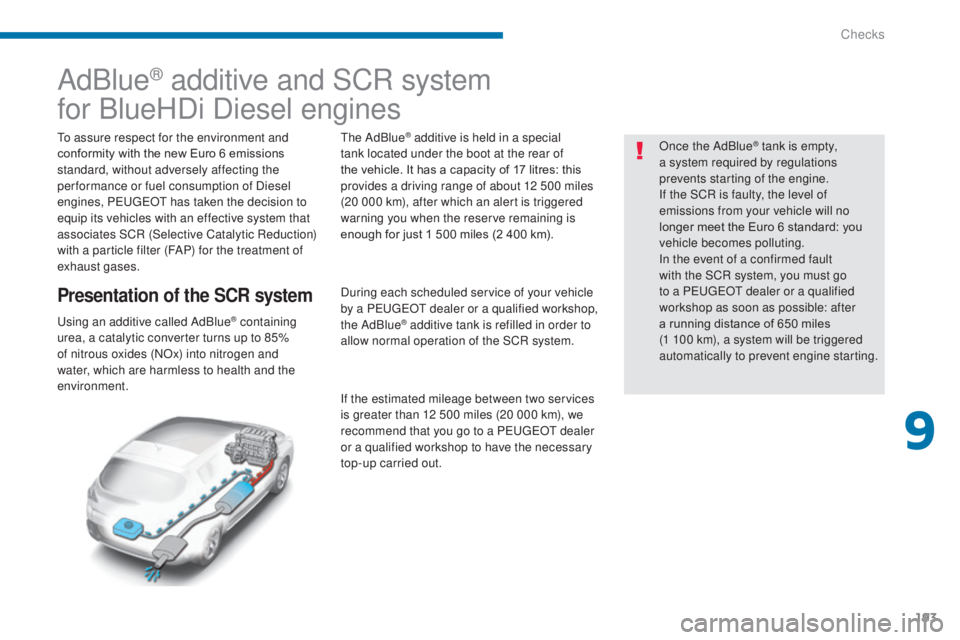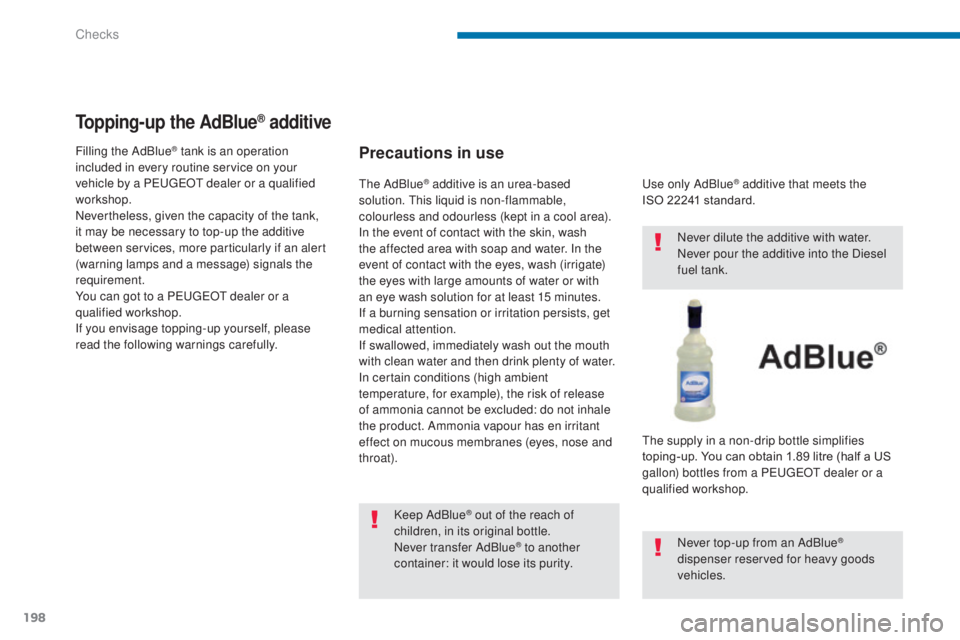Page 186 of 344

184
3008_en_Chap09_verifications_ed01-2015
Running out of fuel (Diesel)
Other engines
F Add at least five litres of Diesel fuel to the tank.
F
O
pen the bonnet.
F
I
f necessary, unclip the styling cover for
access to the priming pump.
F
S
queeze and release the priming pump
repeatedly until resistance is felt (there
may be resistance at the first press).
F
O
perate the starter to start the engine
(if the engine does not start at the first
attempt, wait around 15 seconds before
trying again).
F
I
f the engine does not start after a few
attempts, operate the priming pump again
then start the engine.
F
R
efit the styling cover and clip it in place.
F
C
lose the bonnet.
On vehicles fitted with Diesel engines, the fuel
system must be primed if you run out of fuel.
For all versions other than BlueHDi, refer to the
corresponding engine compartment view.
For more information on the Diesel
misfuel prevention device, refer to the
corresponding section.
If the engine does not start first time,
don't keep trying but start the procedure
again from the beginning.
BlueHDi engines
F Fill the fuel tank with at least five litres of Diesel.
F
S
witch on the ignition (without starting the
engine).
F
W
ait around 6 seconds and switch off the
ignition.
F
R
epeat the operation 10 times.
F
O
perate the starter to run the engine.
Checks
Page 189 of 344
187
3008_en_Chap09_verifications_ed01-2015
Underbonnet - Diesel engines
The various caps and covers allow access for checking the levels of the various fluids, for replacing certain components and for priming the fuel system.
1.
P
ower steering reservoir.
2.
S
creenwash and headlamp wash reservoir.
3.
C
oolant header tank.
4.
B
rake fluid reservoir. 5.
B
attery / Fuses.
6.
Fusebox.
7.
A
i r f i l t e r.
8.
E
ngine oil dipstick.9.
E
ngine oil filler cap.
10.
P
riming pump*.
11.
E
arth point ("-" terminal).
* Depending on engine.
9
Checks
Page 195 of 344

193
3008_en_Chap09_verifications_ed01-2015
AdBlue® additive and SCR system
for BlueHDi Diesel engines
To assure respect for the environment and
conformity with the new Euro 6 emissions
standard, without adversely affecting the
per formance or fuel consumption of Diesel
engines, PEUGEOT has taken the decision to
equip its vehicles with an effective system that
associates SCR (Selective Catalytic Reduction)
with a particle filter (FAP) for the treatment of
exhaust gases.
Presentation of the SCR system
Using an additive called AdBlue® containing
urea, a catalytic converter turns up to 85%
of nitrous oxides (NOx) into nitrogen and
water, which are harmless to health and the
environment. The AdBlue
® additive is held in a special
tank located under the boot at the rear of
the vehicle. It has a capacity of 17 litres: this
provides a driving range of about 12 500 miles
(20 000 km), after which an alert is triggered
warning you when the reserve remaining is
enough for just 1 500 miles (2 400 km).
During each scheduled service of your vehicle
by a PEUGEOT dealer or a qualified workshop,
the AdBlue
® additive tank is refilled in order to
allow normal operation of the SCR system.
If the estimated mileage between two services
is greater than 12 500 miles (20 000 km), we
recommend that you go to a PEUGEOT dealer
or a qualified workshop to have the necessary
top-up carried out. Once the AdBlue
® tank is empty,
a
system required by regulations
prevents starting of the engine.
If the SCR
is faulty, the level of
emissions from your vehicle will no
longer meet the Euro 6 standard: you
vehicle becomes polluting.
In the event of a confirmed fault
with the SCR system, you must go
to a PEUGEOT dealer or a qualified
workshop as soon as possible: after
a running distance of 650 miles
(1
100 km), a system will be triggered
automatically to prevent engine starting.
9
Checks
Page 200 of 344

198
3008_en_Chap09_verifications_ed01-2015
Topping-up the AdBlue® additive
Precautions in use
Keep AdBlue® out of the reach of
children, in its original bottle.
Never transfer AdBlue
® to another
container: it would lose its purity. Use only AdBlue
® additive that meets the
ISO
22241 standard.
The AdBlue® additive is an urea-based
solution. This liquid is non-flammable,
colourless and odourless (kept in a cool area).
In the event of contact with the skin, wash
the affected area with soap and water. In the
event of contact with the eyes, wash (irrigate)
the eyes with large amounts of water or with
an eye wash solution for at least 15 minutes.
If a burning sensation or irritation persists, get
medical attention.
If swallowed, immediately wash out the mouth
with clean water and then drink plenty of water.
In certain conditions (high ambient
temperature, for example), the risk of release
of ammonia cannot be excluded: do not inhale
the product. Ammonia vapour has en irritant
effect on mucous membranes (eyes, nose and
throat). Never dilute the additive with water.
Never pour the additive into the Diesel
fuel tank.
The supply in a non-drip bottle simplifies
toping-up. You can obtain 1.89 litre (half a US
gallon) bottles from a PEUGEOT
dealer or a
qualified workshop.
Never top-up from an AdBlue
®
dispenser reserved for heavy goods
vehicles.
Filling the AdBlue
® tank is an operation
included in every routine service on your
vehicle by a PEUGEOT dealer or a qualified
workshop.
Nevertheless, given the capacity of the tank,
it may be necessary to top-up the additive
between services, more particularly if an alert
(warning lamps and a message) signals the
requirement.
You can got to a PEUGEOT dealer or a
qualified workshop.
If you envisage topping-up yourself, please
read the following warnings carefully.
Checks
Page 244 of 344
242
3008_en_Chap11_caracteristiques_ed01-2015
Engine1.2 litre PureTech 130 S&S 1.6 litre THP 163 1.6 litre THP 165 S&S
Gearbox Manual
(6-speed) Automatic
(6-speed) Automatic
(6-speed)
Model code HNYM/S
HNYM/1S 5FMA /1
5FM A /1D 5G Z T/S
5G Z T/1S
Cubic capacity (cc) 1 1991 598 1 598
Bore x stroke (mm) 70 x 90.577 x 85.8 77 x 85.8
Max power: EU standard (kW)* 96120 121
Max power engine speed (rpm) 5 5006 000 6 000
Max torque: EU standard (Nm) 230240240
Max torque engine speed (rpm) 1 7501 400 1 400
Fuel Unleaded petrolUnleaded petrolUnleaded petrol
Catalytic converter yesyesyes
Engine oil capacity (in litres)
(with filter replacement) 3.5
4.25 4.25
Petrol engines and gearboxes
* The maximum power corresponds to the type approved value on a test bed, under the conditions defined in European legislation
(directive 1 999/99/CE).
Technical data
Page 247 of 344
245
3008_en_Chap11_caracteristiques_ed01-2015
Engine1.6 litre e- HDi 1151.6 litre BlueHDi 115 S & S 1.6 litre BlueHDi 120 S&S
Gearbox ETG6 electronic
(6-speed) Manual
(6-speed) EAT6 automatic
(6-speed) Manual
(6-speed) EAT6 automatic
(6-speed)
Model code 9HD8/PSBHXM/S
BHXM/1S BH X T/1S
BH X T/2S BHZM/S
BHZM /1S BHZ T/1S
BHZ T/2S
Cubic capacity (cc) 15 6 01 560 1 560
Bore x stroke (mm) 75 x 88.375 x 88.3 75 x 88.3
Max power: EU standard (kW)* 8484 88
Max power engine speed (rpm) 3 6003 500 3 500
Max torque: EU standard (Nm) 270300 300
Max torque engine speed (rpm) 1 7501 750 1 750
Fuel DieselDiesel Diesel
Catalytic converter yesyes yes
Particle filter yesyes yes
Engine oil capacity (in litres)
(with filter replacement) 3.75
- -
Diesel engines and gearboxes
* The maximum power corresponds to the type approved value on a test bed, under the conditions defined in European legislation
(directive 1 999/99/CE).
11
Technical data
Page 248 of 344
246
3008_en_Chap11_caracteristiques_ed01-2015
Diesel engines and gearboxes (continued)
* The maximum power corresponds to the type approved value on a test bed, under the conditions defined in European legislation (directive 1 999/99/CE).
Engine
2.0 litre BlueHDi 136 S&S2.0 litre BlueHDi 150 S&S
Gearbox Manual
(6-speed) Manual
(6-speed)
Model code AHSM/S
AHSM/1S AHRM/S
AHRM/1S
Cubic capacity (cc) 1 9971 997
Bore x stroke (mm) 85 x 8885 x 88
Max power: EU standard (kW)* 10 011 0
Max power engine speed (rpm) 4 0004 000
Max torque: EU standard (Nm) 370370
Max torque engine speed (rpm) 2 0002 000
Fuel DieselDiesel
Catalytic converter yesyes
Particle filter yesyes
Engine oil capacity (in litres)
(with filter replacement) -
-
Technical data
Page 253 of 344
251
3008_en_Chap11_caracteristiques_ed01-2015
Identification markings
A. Vehicle Identification Number (VIN) under the bonnet. T
his number is engraved on the bodywork near the
damper support.
B. Vehicle identification Number (VIN) on the windscreen lower crossmember.
T
his number is indicated on a self-adhesive label which is
visible through the windscreen.
C. Manufacturer's label. T
he VIN is indicated on a self-destroying
label affixed to the door aperture, on the
driver's side. D. T
yre/paint label.
T
his label is fitted to the middle pillar, on
the driver's side.
It bears the following information:
-
t
he tyre inflation pressures with and without
load,
-
t
he tyre sizes,
-
t
he inflation pressure of the spare wheel,
-
t
he paint colour code.
Various visible markings for the identification and tracing of your vehicle.
Low tyre pressures increase fuel
consumption.The tyre pressures must be checked
when the tyres are cold, at least once
a month.
11
Technical data